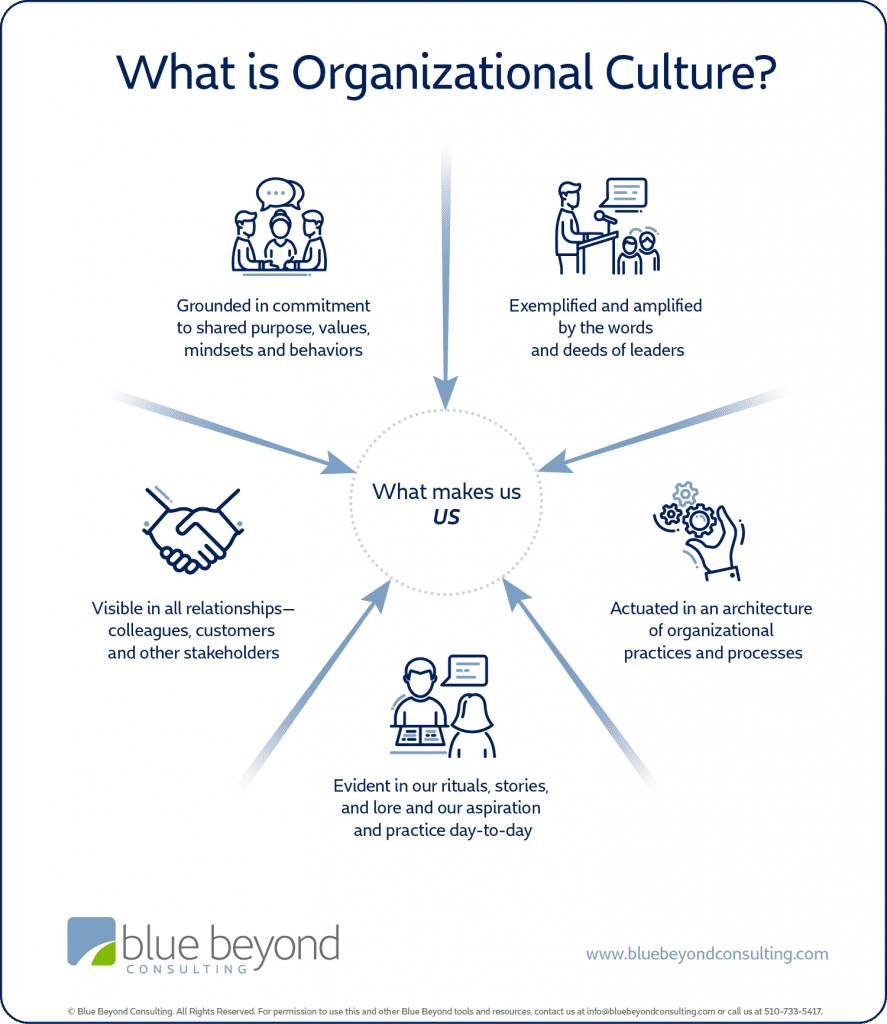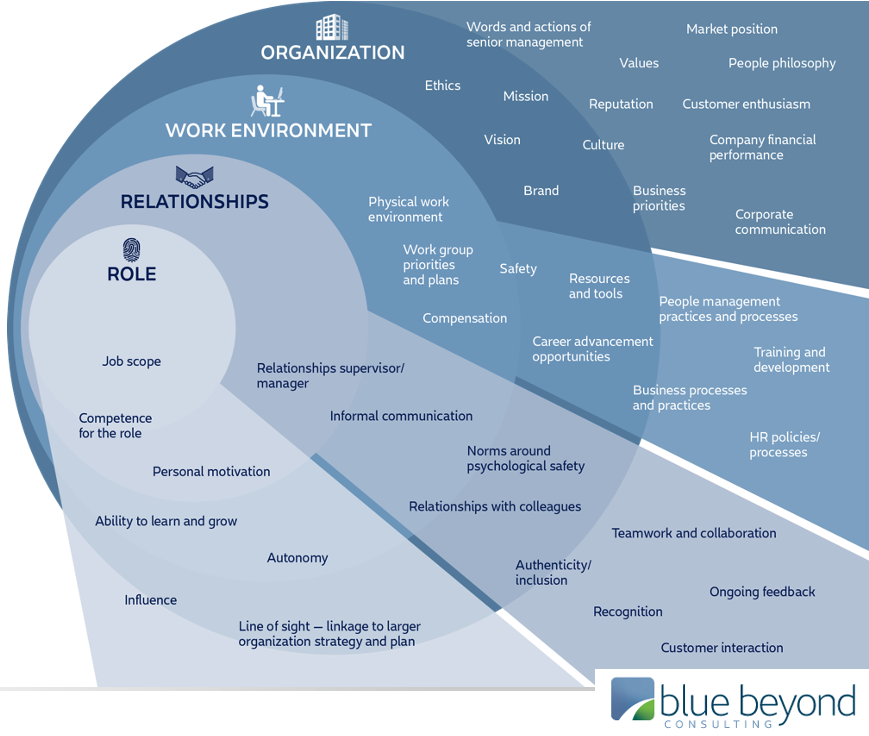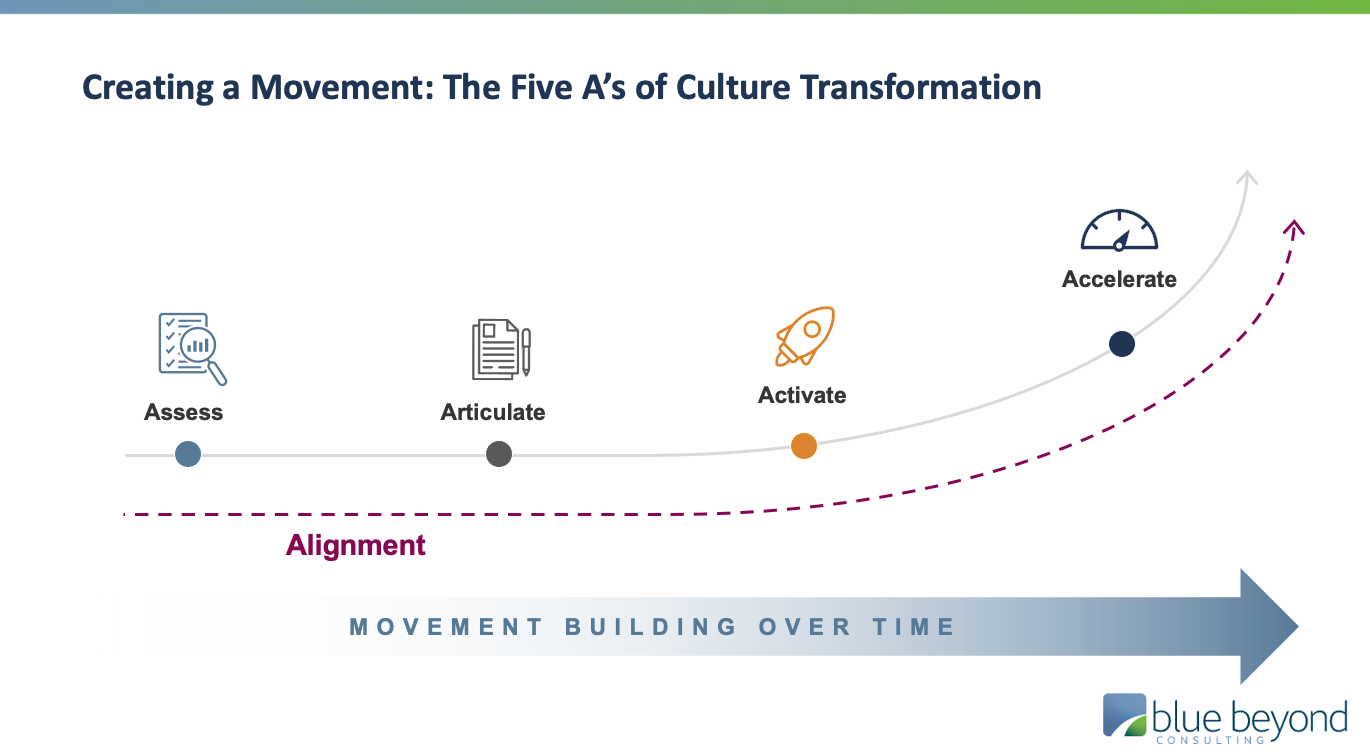Ultimate Guide to Organizational Culture: Definition, Strategies, and Why it Matters
Deep Trust and High Expectations® cultures lead to stronger company performance and happier employees. 88% of prospective employees cite organizational culture as an important factor in their job search. Companies thrive and grow by ensuring their culture is meeting the professional and personal needs of current and potential employees.
Let’s take a closer look at what organizational culture is, why it’s important, and specific examples of how you can transform your organization’s culture.
What is Organizational Culture?
Organizational culture is defined as a set of shared company beliefs, values, and expectations that define the workplace environment and employee experience. By clearly outlining these shared beliefs, values, and expectations for your employees, you’ll inherently guide people to act and behave in a certain way.
Also known as “workplace culture,” “company culture,” or “corporate culture,” organizational culture is upheld by similar values across the organization but may differ in how it’s presented based on what industry you’re a part of. For example, a healthcare organization’s culture may drastically differ from a creative marketing agency’s culture – and that’s okay. Resilient company cultures are where leaders instill Deep Trust and High Expectations® principles across their teams, even when individual needs and skills differ.

At Blue Beyond Consulting, we know that when your company culture is aligned with your business strategy, it will be:
- Grounded in a commitment to shared purpose, values, mindsets, and behaviors
- Exemplified and amplified by the words and deeds of your leaders
- Actuated in an architecture of organizational practices and promises
- Evident in your rituals, stories, and daily practices
- Visible in all relationships you hold, including employees, stakeholders, and customers
Overall, strong organizational culture is a key differentiator between high-performance companies and those who barely meet average benchmarks. Here’s why.
The Importance of Organizational Culture
Great Culture Builds Better Organizations
A good business strategy hinges on a strong culture. 94% of entrepreneurs say that a healthy organizational culture is key to company success. We echo this tenfold. Our research shows that companies with an effective culture deliver superior business results over companies that don’t prioritize Deep Trust and High Expectations® environments. Here’s that success by the numbers:
4.2x
better average annual profits
2.1x
greater annual revenue
40%
lower turnover
4x
higher profit per employee
>2x
higher average market returns
2.8x
better revenue per employee
Source: GPTW, The Employee Experience Advantage, Deloitte
How do these results come to be? Well, when companies prioritize a well-integrated culture, it empowers teams to execute work together seamlessly, improving collaboration, communication, efficiency, and effectiveness across the board. To drive growth while still prioritizing your people, it’s important to consider how your culture reinforces the purpose and values people can get behind.
Great Culture Intersects with Purpose and Values
Your company’s purpose and values should work hand in hand to help you create and sustain an inclusive culture where both the business and people thrive. Your culture should communicate the essence of what your company offers — to customers, employees, and stakeholders — in a way that inspires trust and credibility.
There are a number of ways to create an organizational culture that promotes the shared purpose and values of your employees, customers, and stakeholders. The best approach for you will vary, or may even be a blend of the following.
5 Elements of a Thriving Organization
Here are five elements that can help you build a high-performance organization. Having these articulated within your organization can equip leaders with the tools and clarity to engage the organization.
| Element | Description |
| Purpose | The motivating force behind what your organization does. Your purpose will answer: why do we exist? What good do we aspire to add to the world? |
| Values | A set of core beliefs held by a company. Your values will answer: what commitments define our character? What mindsets, norms, and behaviors do we prize most highly? |
| Brand Promise | What experience customers can expect by interacting with your company? Your brand promise will answer: what is our offer to customers? What is the value and experience people who do business with us can expect? |
| Employee Value Proposition (EVP) | The unique value you offer to your employees in order to continue having them work for you. Your EVP will answer: what is our offer to our employees? What is the value and experience people who work for us can expect? Learn more about how one company instilled employee commitment and attracted new talent through its refined EVP. |
| Culture | We’ve covered this one in-depth, but it can be quickly defined as a shared set of company beliefs, values, and expectations that guide employee behaviors and actions. Your culture will answer: what makes us distinctly us? What ways of being enable us to be most effective together? By thinking about the characteristics you want your culture to embody, you can define a path forward for sustainable culture change. |
Characteristics of Organizational Cultures
Every organization’s culture is unique, with distinct characteristics that show up in varying degrees. Some examples include:
- Collaborative:
- Pros: Highly focused on teamwork, promoting autonomous work, and discouraging micromanagement
- Cons: Ambiguous roles and responsibilities can lead to a lack of ownership
- Command and control:
- Pros: Top-down management culture encourages chain of command so people clearly understand their roles and responsibilities within the organization
- Cons: May lead to a more impersonal or strict working environment
- Idea generating:
- Pros: Free-flowing ideas are generated when employees have the freedom to create and learn on their own
- Cons: Employees that thrive in structured environments may find it hard to succeed in this type of workplace
- Competitive:
- Pros: Encourages hitting certain KPIs in order to climb the corporate ladder
- Cons: Fosters competition amongst peers, which may lead to dissatisfaction with interpersonal work relationships
- Leading by example:
- Pros: Leading in order to encourage junior employees to follow suit so you’re all working with the same purpose and values in mind
- Cons: Can be very fast-paced and may not be the best fit for those that would prefer not to be in a leadership position
- Customer-first:
- Pros: Prioritizing market research and customer feedback as the pillars of success
- Cons: May lead to profit drops if not managed properly (e.g., the return policy is abused, too many discounts, leading to a loss in profits)
- Skill-based:
- Pros: Wages are determined based on skills rather than hierarchical position, so it’s more equitable across the board
- Cons: The flat hierarchy makes it harder to recruit highly skilled workers since salaries are banded to be fair and equal rather than merit-based
- To-do list:
- Pros: Highly task-focused cultures encourage employees to step up and take on new tasks outside their job descriptions to expand their skill sets
- Cons: May promote burnout among employees that are taking on more than they can handle
- Consensus building:
- Pros: Creates a sense of accountability among employees and key stakeholders by prioritizing inclusion and belonging in everything the company does, sense of inclusion, alignment
- Cons: Time, decision making
It’s not a one-size-fits-all solution. As you think about what type of culture you want to build for your own organization, evaluate where you are currently. Ask yourself: What do we want to build on? What do we need to evolve? What characteristics will help our organization succeed and enable our people to thrive? If we move forward with this path, will everyone be on board? If not, to what degree are we ok with that, given where we need to go in the future? Are leaders aligned and bought into the change? After all, ownership of your culture’s success requires buy-in from everyone.
How to Identify Your Culture With a Culture Assessment
When beginning your culture change journey, it’s important to first do a culture assessment that looks at the strengths and gaps within your organization’s culture. By uncovering these insights, you’ll be able to design a culture change initiative that reflects the employee experience and drives lasting change.
Defining Organizational Culture
In order to define your organizational culture, it’s important to understand the everyday employee experience. We do this by looking at four key areas:

By understanding which factors are most important to employees, you can shift priorities to fit this context and better engage your people in championing what beliefs, values, and actions exemplify your ideal organizational culture.
Organizational Culture Assessment Case Study
For an example of how this works, let’s look at a culture assessment we conducted for a global supply chain software company that had a goal of becoming a billion-dollar enterprise. In order to scale the company, they knew they needed to outline what parts of the current state culture were working and what needed a revamp. When diving into the work, they found that employees often felt disconnected and unengaged around the company’s values, culture, and strategy. By bringing Blue Beyond in, they started collectively working toward creating a set of shared values that not only resonated with employees but also fueled international growth.
To identify what values employees would buy into, we began by conducting numerous one-on-one meetings with executive leaders and cross-functional, global employee focus groups. In these meetings, we uncovered both strategic and culture issues employees were facing amidst a time of rapid growth and change and found that employees were highly engaged in preserving what already existed within their culture but were having a tough time envisioning what was coming next. This culture assessment enabled Blue Beyond to develop a sound recommendation on what leaders should do to evolve the organization’s identity while still preserving elements that made them strong. For more information, read the full case study.
Organizational Culture Amidst Change
Are you facing a major organizational change? Culture norms of trust, empowerment, accountability, transparency, inclusion, belonging, learning, agility, and innovation are all incredible assets to lean on in times of change. By prioritizing these norms, you will either support or detract from other change initiatives happening, building resilience rooted in a strong culture foundation along the way.
If you need support, reach out to our team of experts – we’d be happy to help support your change management initiative while also monitoring your culture needs.
What Is Culture Transformation?
Culture transformation is about building a movement that solicits the hearts and minds of your employees in order to encourage positive mindsets, behaviors, and norms that propel your organization forward. Cultures that maintain deep trust and high expectations are proven to deliver better results for both their business and people. At the end of the day, it’s all about working with the same end goal in mind.
What Prompts an Organization to Change Its Culture?
In short, a better work environment leads to stronger company performance. If culture doesn’t keep up with the changing needs of employees, it’s hard to mask it. 86% of job seekers cite bad company reputation as a key reason why they wouldn’t apply to or take a job at a company. By not fostering a strong culture, you’re missing out on key applicants, as well as opportunities to retain your existing employees. Additionally, given that profits are very closely tied to employee satisfaction and team well-being, your company’s performance directly depends on the success of your culture.
How Are Culture Changes Communicated?
Effective communication around change is key to buy-in and success – this goes for organizational culture as well to ensure that all employees play an active role in championing the change. When communicating change to your leaders and employees, make sure they understand the why — and the why now? It’s also important to consider your tone of voice, what your key messages are if you’re being transparent in your delivery, and if you’re giving a chance for your team members to feel engaged in the process. Culture change isn’t done to people; it’s done with and through them.
The communication around change should be part of a bigger picture strategy that promotes cultural sustainability and employee engagement.
Strategies to Build Culture That Sticks
As you get closer to the implementation of your culture change initiative, consider what strategies you’re going to take in making sure it’s sustainable over time. A few key strategies we recommend incorporating into your plan include:
- Match up your business strategy with your culture strategy so they work in tandem.
- Be reasonable in your approach by focusing on key areas of behavior change to implement.
- Create a roadmap – culture change is a movement that takes time – spend time planning and sequencing efforts so employees can connect the dots across their experience.
- Embed culture across the talent lifecycle and, in particular, into your performance management processes.
- Don’t lose sight of the strengths you already have within your organization – harness those and keep them as a part of your future state culture.
- Introduce key metrics and interventions that are measurable to evaluate culture change success.
Remember that culture is something that requires ongoing evaluation and nurturing. It doesn’t happen overnight and requires your teams to remain engaged in the change in order to continue seeing progress and high-performance results.
The Relationship Between Culture and Leadership
The relationship between culture and leadership is a strong one – companies see a 70% difference in culture quality when they have highly effective, engaged leaders.
Workplace norms are created when leadership team members demonstrate them for other employees to follow. By aligning leaders around vision and purpose and clarifying how culture is linked to future business success, you can then equip company managers to lead the way.
Encourage your organization’s leaders to take a larger role in culture change by:
- Ensuring they understand your current culture and future-state vision
- Providing materials that clearly define the purpose, values, and behaviors of your culture
- Sharing expectations around upholding this culture
- Engaging them in the change process to ensure they advocate for what they’re co-creating
- Explaining why this culture change or evolution is needed and why it’s happening now
- Recognizing talent that upholds cultural values in a way that achieves organizational goals
- Equipping them with stories of ‘culture in action’ to share that exemplify best practices
You can encourage this ownership by focusing on building an organizational culture and “muscle” around continuous development, feedback, and coaching. And by actively engaging leaders in helping move the organization forward, your culture will follow suit.
3 Examples of Highly Effective Organizational Cultures
Need a few examples of companies who have made their culture a priority? Here are three that stand out – and that you maybe haven’t heard of:
- Atlassian – With over 10,000 employees, Atlassian uses their shared company values to set the tone and define the work they take on, who they hire, and their employee engagement strategy organization-wide. Atlassian’s distinct values govern their culture, demonstrating that what you see is what you get. This way of working has landed the company on the Fortune’s Top 10 Companies to Work For list and a Great Place to Work certification.
- Ingredion – As a solution-oriented global manufacturing company and Fortune 500 list member, Ingredion links its purpose and values to motivate its workforce and work towards its vision to “make life better.” The company takes every opportunity to feature this slogan in its internal stories, employee recognition, and external communications.
- Nordstrom– As a customer-first culture, Nordstrom highly prioritizes an environment where employees, customers, and vendors all feel appreciated for the skills they bring to the table and the decisions they make on the job. All employees are empowered by leaders to make decisions that are in the best interest of the customer in front of them by using their best judgment.
Despite having three varied types of organizational culture, what do all of these companies have in common? They all found what works best for their unique needs and engaged all of their employees equally in owning their individual part in it.
Bringing Your Organizational Culture to the Next Level
We’ve demonstrated that the benefits of a thriving organizational culture are powerful – if you’re ready to undergo lasting culture change for your organization, consider how Blue Beyond Consulting’s unique expertise and approach could support your team’s needs. We learn from and work with your team to deliver your desired outcomes. To do this we:
- Assess: Diagnose current state of culture – through employees’ candid perceptions of present-day realities, as well as their hopes and aspirations for the future – and gain leadership alignment around the value of and opportunities for nurturing and sustaining a well-integrated, high-performance culture.
- Articulate: Determine, align around, and articulate the behavioral expectations that underscore a shared vision and one-company mindset, and do so in ways that excite and mobilize your employees in service of helping to build and sustain a high-performing team.
- Activate: Develop a strategy and work plan that bolsters the culture and employee experience across the organization – from both an enterprise and business unit perspective – and supports your efforts to gain leader buy-in and enable effective leadership sponsorship and involvement.
- Accelerate: Put change into action by executing your strategy and work plan. We act as a collaborative partner to help you move your organization forward.
- Align: Ensure that stakeholders at all levels within your company understand the “what” and “why” of your culture journey every step of the way.

Ready to elevate your virtual leadership?
At Blue Beyond, we are people-side-of-business experts with decades of experience in activating employees, managers, and leaders. Are you ready to unleash their potential? Let’s talk.
